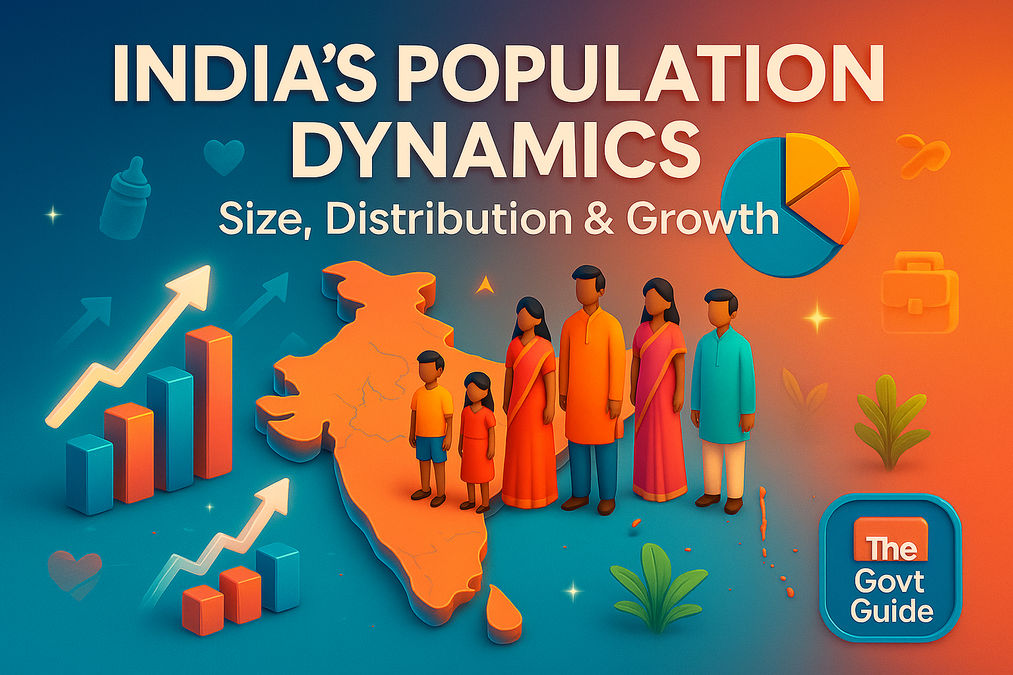India's Population Dynamics: Size, Distribution & Growth Trends
India's Population Dynamics: Size, Distribution & Growth Trends

India's population dynamics are a critical aspect of its socio-economic landscape. With a population of 1,210.6 million as per the 2011 Census, India accounts for over 17% of the world's population, despite occupying only 2.4% of the global land area. This article delves into the size, distribution, density, and growth trends of India's population, offering insights into the factors shaping these dynamics.
Did You Know? India overtook China in 2023 to become the world's most populous country, highlighting the significance of understanding its population dynamics.
Population Size and Distribution
India's population is unevenly distributed across its 3.28 million square kilometers. The 2011 Census highlights Uttar Pradesh as the most populous state with 199 million people, accounting for 16% of India's population. In contrast, smaller regions like Sikkim (0.6 million) and Lakshadweep (64,429) have minimal populations. Nearly half of India's population resides in five states: Uttar Pradesh, Maharashtra, Bihar, West Bengal, and Andhra Pradesh.
| State/Region | Population (2011, in millions) | Percentage of India's Population |
|---|---|---|
| Uttar Pradesh | 199 | 16% |
| Maharashtra | 112.4 | 9.3% |
| Bihar | 104.1 | 8.6% |
| West Bengal | 91.3 | 7.5% |
| Andhra Pradesh | 84.6 | 7% |
Population Density
Population density, measured as persons per square kilometer, reveals stark contrasts across India. The national average in 2011 was 382 persons per sq km, with Bihar recording the highest at 1,102 and Arunachal Pradesh the lowest at 17. This uneven distribution is influenced by terrain, climate, and economic opportunities.
Insight: Fertile plains like the Northern Plains and Kerala support high population densities due to favorable agricultural conditions, while hilly and arid regions like Rajasthan remain sparsely populated.
Timeline of India's Population Growth
1951: Population at 361 million, with an annual growth rate of 1.25%.
1981: Population reached 683 million, with a peak growth rate of 2.22%.
2011: Population hit 1,210.6 million, with a growth rate of 1.64%.
2023: India surpassed China to become the most populous country globally.
Processes of Population Change
Population dynamics are driven by three processes: birth rates, death rates, and migration. Birth rates (live births per 1,000 persons) have historically been higher than death rates, contributing to population growth. Since 1981, declining birth and death rates have slowed the growth rate, though the absolute increase remains significant due to India's large population base.
Conclusion
India's population dynamics reflect a complex interplay of size, distribution, and growth factors. Understanding these trends is crucial for effective resource management and policy planning. The National Population Policy 2000 and ongoing efforts in education and health are steps toward sustainable development.
Frequently Asked Questions
What is India's population as per the 2011 Census?
India's population as per the 2011 Census was 1,210.6 million, accounting for over 17% of the world's population.
Which state has the highest population in India?
Uttar Pradesh, with a population of 199 million, is the most populous state in India as per the 2011 Census.
What is population density, and how does it vary in India?
Population density is the number of persons per square kilometer. In 2011, India's average was 382 persons per sq km, varying from 1,102 in Bihar to 17 in Arunachal Pradesh.
Why is India's population unevenly distributed?
Uneven distribution is due to factors like terrain, climate, soil fertility, and economic opportunities. Fertile plains like the Northern Plains have higher density, while rugged areas like Arunachal Pradesh have lower density.
What are the main processes of population change?
The main processes are birth rates, death rates, and migration, which influence population size, distribution, and composition.
Join the conversation